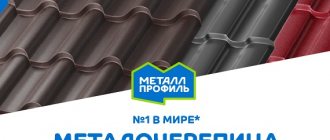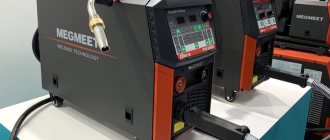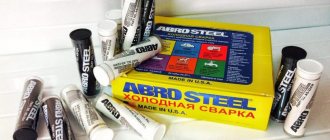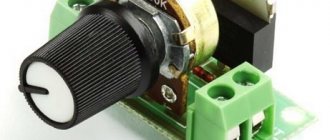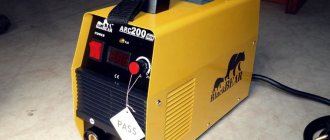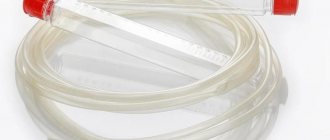Rating of the best spotters for welding 2022 in 2022 buy. TOP - 10 overview of the best reviews. Rating of the best spotters for welding 2022 in Russia list 2022 - 2022.
Carrying out work on straightening a car body often comes down to more than just basic skills in working with standard tools. Almost always you will need knowledge of design features, the geometry of body parts, and maintaining banal accuracy plays an important role. Even if you have very rich experience and knowledge in this matter, you will need to use a special tool, which is a spotter.
Spotter - general information
This word is used all over the world to describe all types of resistance welding tools (from the English spot - “point”). In the former post-Soviet space, this is the name given to single-sided welding machines used for repairing body surfaces of various types of vehicles, and the set of which includes a reverse hammer. The main purpose of using a spotter is to eliminate the need to replace a damaged part and instead carry out spot repairs, which allows you to save on running costs.
Any professional straightener knows that spot welding is indispensable for complex body geometry. Using this tool, the surface on the machine is processed in any place, regardless of inaccessibility. Working with the tool is quite simple and does not require long training - that is why the devices have become widespread.
The device, in fact, is universal - it is well suited for straightening body parts, such as: hood, sills, doors, fenders, etc. The main function of the device is to create a straightening force with fixation on the outside of the part.
Optimal selection rules
Modern companies that produce tools for body repair offer a very large selection of models that differ in type, size, power, range of options and features of practical work.
There are a number of criteria and technical characteristics that determine the buyer’s choice:
- Type of operation of the device.
- List of materials for which the straightening function is available. The future owner should definitely find out what materials the selected spot welding model cannot work with (copper, aluminum, steel, galvanized surfaces).
- Please note that there are different operating modes.
- The shape of the gun and nozzles included with the spot welding machine are important.
- When inspecting a future purchase for the first time, you need to find out the length of the cable (important for practical activities) and the reliability of the gun’s fastening.
- For ease of use, the size of the structure and its weight matter. All mobile spot welding machines have a weight in the range of 12-24 kg. There are models of devices on trolleys that can weigh up to 95-100 kg.
- Do not forget to evaluate the dimensions of the structure in order to select a working platform for the device.
- One of the most important characteristics is the power of a spot welding machine for body repair. The output current must be at least 3000 Amperes. However, this value is very arbitrary, since for various tasks there is a certain parameter for the operation of the device. For example, to weld a wire you will need 1000 Amps, and to work with a copper-plated electrode you will need up to 1400 Amps.
At the stage of choosing a tool, the owner should determine the scope of the upcoming tasks.
For minor household car repairs, small compact devices are used. If the thickness of the metal with which the work will be carried out is 1.5-2.0 mm, preference should be given to a double-sided machine (welding is carried out simultaneously with two electrodes).
To organize your own service station, you need a device with a large number of functions, sufficient power and a full set of attachments for the gun.
Operating principle and device
In a nutshell, a spotter is used to heat up a small area of a body element that needs to be freed from deformation unforeseen by the design. In this case, minimal damage is caused to the car itself.
The simplest spotter tool consists of:
- Housings;
- Electrical cable;
- Stadder attachments;
- An ordinary electrode (it can be replaced with a pointed tip).
Any casing that is safe enough when performing work can act as a housing. You can make a spotter yourself, but such a device is unlikely to cope with long-term operating conditions - only factory models are suitable for this.
The welding procedure includes the following steps:
- A fastening element is attached (welded) to the damaged area;
- The return hammer of the device clings to the latch;
- Pulling is done using the muscular strength of a person, but sometimes additional tools are used.
The processing process itself does not require any special effort and straightening can be carried out in a standard garage.
How to work as a spotter
Working as a spotter, auto straightening has been perfected by many specialists, but the technique is not particularly difficult for beginner straightening artists. Using the device, it is possible to level out a dent in any area, regardless of location.
The electrode receives current from the welding machine, thus making a connection to the deformed area. For straightening, a reverse hammer is used, which can be replaced with a special stop. Mechanical influences continue until the surface is completely leveled. After completion of the work, the area is cleaned, as slag from the electrode remains on it.
To learn how to use a spotter, you don’t need to go to special courses
Algorithm for using a spotter for straightening:
- Surface preparation. Regardless of the body material (aluminum or iron), all coatings are removed from the surface: paint layer, putty, primer.
- Connection "minus". A negative terminal is connected to the body for grounding.
- Installation of fasteners. The clamps (any hooks, loops or hooks) are welded to the deformed area of the body. Spot welding is used for connection.
- Tool preparation. The main tool is coupled and auxiliary structures are prepared. It is convenient to use a puller - a device to facilitate the restoration of parts.
- Editing a detail. Pulling out the body element until the original appearance and shape is restored.
- Removing fasteners. A grinder is suitable for removing the clamps.
- Grinding. The final stage is cleaning the surface and preparing for painting.
To use the tool professionally, you need minimal skills in handling a welding machine. A specialist can easily determine the type of spotter attachment needed and its size. A large set of attachments will allow you to work with power elements without disassembly.
Removing small dents
There are several fundamental differences between the alignment of small and large-scale dents:
- only one hook is fixed for pulling;
- cleaning is carried out exclusively on the deformed area, the rest of the paintwork is not touched;
- the part is covered with masking tape around the perimeter to prevent paint destruction;
- It is recommended to perform straightening carefully, without applying strong force, to avoid deformation of the entire part.
The operating algorithm remains the same, but additionally small attachments are used.
If we compare a regular welding machine, we can say that the spotter is much safer, since it does not produce sparks and does not heat up the metal
Dealing with serious damage
Repairing major damage will require extensive work:
- many fasteners are welded along the dent, mainly in places of the deepest damage;
- each element should be pulled out a little - and so on in a circle until complete restoration. If you immediately level one section, at the time of straightening the second, the condition of the previous place may be disrupted;
- A relatively large reverse hammer will come in handy, but strong impacts should still be avoided, otherwise there is a risk of damaging the fastening of the body element.
Types of spotters
In total, there are two main types of tools: transformer and inverter. Depending on the method and area of use, two more classes are distinguished: for welding the body using the contact method and for straightening.
Straightening spotters are small devices designed for small work. They require the installation of a reverse hammer and additional attachments to perform repairs. In addition, the design may include special pliers. However, many of these devices have low power, are prone to rapid overheating, and therefore are not able to provide high-quality welding.
In addition, spot welding equipment can be classified according to the power supply voltage consumed from the electrical network. Standard tools are designed for 220V, and the most powerful ones are designed for 380V.
Spotter, what is it?
Every straightener knows what a spotter is; it is indispensable for most body restoration work. A spotter for body repair is a device that helps prevent the complete dismantling of body elements during straightening work. The surface on the car using the device is displayed in any place, regardless of accessibility.
Spotter has an important advantage - it helps restore complex geometry on any body parts. The device is especially effective in places where there is no access to the inside of the element. Working as a spotter is not difficult, and this has contributed to the spread of the device. Additionally, powerful devices are used instead of spot welding.
The device is universal and allows you to straighten various body parts: door, hood, fender, threshold, etc. The main difference of the device is the creation of straightening forces with fixation to the outside of the body part.
Professional body repair cannot do without using a spotter
Detailed usage procedure
The work of smoothing out the dent begins with current being supplied to the electrode from the welding machine. For straightening, a reverse hammer is used, which can be replaced with a pointed stop. Impacts on the deformable surface must be carried out until it is completely leveled. Upon completion of all operations, the processing area must be cleaned, as electrode slag remains on it.
The algorithm for straightening work includes the following steps:
- Preparation of the surface to be treated (regardless of the body material - aluminum or iron), by removing any coating from it, be it putty, paint layer, primer;
- Connecting the “negative” terminal from the device to the vehicle body for grounding purposes;
- Installation of fasteners by welding various fastening devices (loops, hooks and hooks) to the place of deformation, by performing spot welding;
- Equipment preparation – the tool base and additional equipment are coupled (at this stage it is convenient to use a puller);
- Straightening an element, i.e. stretching it in order to restore its original appearance;
- Dismantling fasteners - banal removal of fastening means (usually using a “grinder”);
- The final stage is grinding, during which the surface is cleaned and preparatory work is carried out for subsequent painting.
To perform the above algorithm, minimal knowledge of working with a welding machine is sufficient. If the spotter is equipped with a set of attachments, this will allow you to work with any fastener elements.
Which spot welding machine is better?
The welding machine must be reliable, productive, and as accurate as possible in performing its functions. All presented nominees meet these parameters, reviews confirm this. The recommendations of Vyborexperta.ru will tell you what to choose and buy based on a comparative analysis of the pros and cons of each position:
- Caliber SVA-1.5 AK is a budget compact model of Russian-made pliers;
- Telwin Digital Modular 230 – device with a timer for high-strength steel sheets;
- Blueweld Plus 230 – high power, left-handed/right-handed model, microcontroller;
- Fubag TS 2600 – compact spotter with 5 operating modes, light indication;
- TCC SW-1600 is the highest indicator of accuracy, speed, and efficiency.
The choice of such a welding device should be approached with complete seriousness. In order for the costs to be justified, all factors are taken into account in advance. Conventionally, the nominees can be divided into household and professional designs. Much depends on the frequency of use, level of load, personal needs, and which products will be repaired.
Removing small dents
Despite the similarity of the work algorithms, all work on a small scale has some differences, namely:
- For pulling, a single fastener is fixed;
- Cleaning is carried out only at the site of damage; it is better not to touch the surrounding area;
- The perimeter of the treated area is covered with special (preferably masking) tape so as not to destroy the surrounding paint;
- Straightening is carried out without the use of much effort, again, to avoid damage to the part as a whole.
It may be necessary to use additional attachments.
Repairing deep damage
To eliminate such deformations, large-scale actions will be required, the distinctive features of which will be:
- Welding more fasteners in places of more severe damage;
- The drawing is done more slowly - little by little you need to pull out each element “in a circle”. If one area is completely leveled, then when moving to another the previous result may be destroyed;
- The reverse hammer is used in large sizes, however, heavy blows should still be avoided due to the risk of damaging the fasteners.
Functional orientation of factory-made spotters
Their useful properties include:
- They interact perfectly with repair washers during straightening;
- The metal electrode maintains the connection on a permanent basis for subsequent rapid transition to operations;
- Works great with graphite electrodes;
- Comfort in use and ease of maintenance;
- Support switchable operating modes: long-term and short-term. In the first case, a metal electrode is used, or repair washers are generally used. In the second case, a carbon electrode is installed;
- They have their own cooling system that will automatically turn off the device if it overheats.
Standard characteristics of serial spotters
These include the following variations:
- Power supply type – 220 V/380 V network;
- AC frequency – 50-60 Hz;
- Maximum power – 10 kW;
- When welding, the maximum current reaches 1300 A;
- The voltage generated on the secondary winding is 8-9 V;
- The built-in timer can be set from 0.1 to 1.2 seconds;
- They have the ability to switch welding modes from spot to constant;
- The performance of the device depends on the selected program - with precision, the device operates at maximum power, and with coal welding, the output power is minimal;
- Through the iron electrode, the breaking force is more than 100kg;
- When installing a repair washer, the pulling force is more than 100 kg.
Rating of spot welding machines
The adhesion of the materials is ensured by a seam consisting of many small welded points. To create them, the part is placed between two electrodes; they compress it from below and from above, while simultaneously passing current. There are two types of welding machines - portable and stationary. We conducted research on several dozen devices, evaluating each on a number of indicators:
- Category – household, industrial, professional;
- Type – pliers, portable apparatus, stationary machine;
- Welding method – single-sided, double-sided, combined version;
- Current – maximum indicator, equipment capabilities from 3000 to 10,000 A;
- Speed of work - how many hitch points are left per minute;
- Permissible thickness of materials - which sheets can be overlapped;
- Voltage – single-phase 220 V, three-phase 380 V;
- Control – ease of use, manual, synergistic (microprocessor) setting;
- Noise level – sound pressure in dB during active mode;
- Power – the parameter is measured in kW, the higher it is, the thicker the surface;
- Additional options – cooling system, equipment.
The demand for such devices has been growing over the years. Manufacturers are improving their products, adding new products to the market. We have selected products that have received the highest ratings from experts and the most favorable reviews from customers and ordinary owners. As a result, 7 nominees were identified - 4 ticks, 3 spotters.
The best masks for welders
Completeness of spotter equipment
As a rule, devices made in China immediately come with the maximum number of accessories and attachments and are even equipped with a special cart, so you don’t have to buy anything in addition.
At the same time, European models can’t often boast of a complete camping kit. However, due to the simplicity of the design of the tool itself, there are no problems in using “non-native” attachments when working.
Typically, the design of equipment from Western manufacturers necessarily uses a copper secondary winding of the transformer, which makes it possible to reduce energy consumption at the same current, which significantly reduces the load on the network.
They are also equipped with special smart microprocessors that will eliminate possible incorrect burning of metal. This function has been especially relevant recently, when the global automotive industry began to use metal sheets of very thin thickness (up to 0.6 mm).
Parameters on which the price of a spotter depends
A huge role in the price of a spotter is played by parameters that indicate the current consumed by it, the general quality of performance and functionality. The higher each of the listed parameters, the higher the price of the device. Thus, before purchasing, you should decide on the scope of work for which you will need equipment. If one-time small work is expected, then you should not shell out for professional equipment. If you plan to constantly provide qualified services using this tool (for example, as part of the work of a service station), then you should take care of purchasing powerful equipment.
Among the significant price factors, the following trend can be established:
- Transformer models are cheaper and more reliable, but tools with an inverter type converter perform well in spot welding;
- Higher power models are designed for spot welding and are used for stronger parts. Standard power will be quite enough for straightening individual body elements;
- Tools with double-sided welding have the highest price; moreover, it is performed using special pliers that unfold from the reverse side and instantly create a hook.
How to choose a spot welding machine
Not only price and financial capabilities decide which resistance welding machine to buy. Much depends on the goals, scope of application, as well as technical performance characteristics. We familiarized ourselves with the recommendations of experienced craftsmen, after which we identified the primary criteria - exposure mode, maximum possible welding current, metal thickness, control method, and power consumption.
Impact mode
Modern models operate in two modes of influence on workpieces and parts:
- One-way mode. It is more typical for spotters that are equipped with a gun with a rod, a reverse hammer with an electrode at the end. To weld, you need to grab this part to the surface and perform reverse blows to pull out the metal. This method is appropriate if the impact is carried out in hard-to-reach places, as well as when interacting with large products.
- Two-way mode. This method is appropriate if you need to overlap metal. Ticks that grip the area on both sides will cope with this task. The distance of the points will depend on the reach of the consoles, usually 12-50 cm. The upper console is movable; it is lowered by pressing while simultaneously heating.
Maximum welding current
The capabilities of the equipment directly depend on the welding current limit. For example, if the device produces 3000 A, the overall cross-section will be able to connect parts 3 mm thick. If the parameter is increased to 6000 A, then 4-5 mm steel is “stitched”. Such capabilities are demonstrated by household models; for industrial purposes, reinforced equipment of 10,000-16,000 A has been created, which corresponds to a total thickness of 9 mm.
Thickness of welded metals
This criterion also cannot be ignored when choosing welding equipment. If the instructions indicate that pliers or a spotter will grip sheets 3 mm thick, then work with wider surfaces will be of poor quality. The parameter is designated in two ways - total (for example, 6 mm) or separate (3+3 mm). Industrial versions are capable of simultaneously fastening 3 sheets, then the parameter will be 3+3+3 mm.
Control method
Everyday tasks can be easily solved by a simplified model with manual control. Budget products do not provide for adjusting the current strength, always operating at maximum. With pliers, the operator will need to independently squeeze the consoles, controlling the contact of the electrodes.
Modern, industrial designs are equipped with a synergistic microprocessor control method. For this purpose, a digital panel is provided, where the wizard indicates the type of connection and the thickness of the product. The smart system independently selects the optimal mode and turns on and off the current at the right time. All that remains is to bring the electrodes to the foot area.
Power
The power indicator is selected taking into account the surfaces that will be processed. Refractory metals require a device on which the current can be adjusted over a wide range. For ordinary metal, the standard spot welding option is suitable. A parameter within 5 kW will withstand single-phase voltage, everything above that requires additional measures or a 380 V network.
Ranking of the Best Best Spotting Equipment for 2022
Pilot MT type MINI
One of the most budget-friendly, but at the same time reliable devices on the Russian market. At the end of 2022, it became the most popular equipment among devices of this type among Russians. Compatible with attachments from other manufacturers.
Specifications:
| Name | Index |
| Supply voltage, V | 220 |
| Power consumption, W | 6 |
| Current frequency, Hz | 50 |
| Minimum welding current, A | 200 |
| Maximum welding current, A | 1500 |
| Maximum thickness of welded parts, mm | 2 |
| Weight, kg | 14 |
| Price, rub. | 14000 |
Advantages
- Comes with its own set of attachments;
- Works both with its own puller and with attachments from third-party manufacturers;
- The kit includes 10 repair washers.
Flaws
- It is forbidden to deposit metal with a copper electrode.
Elitech ATS 5
A highly specialized device for car body repair. It is intended to be used only in conjunction with a more powerful model, as its main function is to weld studs for subsequent straightening of parts using a reverse hammer.
Specifications:
| Name | Index |
| Maximum current, A | 15 |
| Power, W | 3500 |
| frequency Hz | 50 |
| Diameter of welded studs, mm | 2020-03-02 00:00:00 |
| Weight, kg | 4 |
| Class | "semi-pro" |
| Price, rub. | 8000 |
Advantages
- Compactness;
- Reasonable price;
- Low power consumption.
Flaws
- Narrow functionality (impossibility of welding even thin sheets of metal together).
Fubag TS 3800
The tool is designed to remove dents from vehicle bodies. It has gained well-deserved popularity due to its convenient pistol, the presence of a microprocessor discharge, and a simple control panel.
Specifications:
| Name | Index |
| Maximum welding current, A | 3800 |
| frequency Hz | 50 |
| Net weight, kg | 23 |
| power, kWt | 7.4 |
| Product height, mm | 235 |
| Voltage, V | 220 |
| Product width, mm | 360 |
| Mains fuse, A | 16 |
| Product length, mm | 225 |
| Price, rub | 24600 |
Advantages
- 7 programmable modes for 11 power options;
- Overheat indicator;
- Light weight.
Flaws
- Relatively short cable - only 4 meters.
Atis S52L
This multifunctional spotter is designed to perform complex work on straightening body surfaces. Equipped with an overheating microprocessor and automatic input of the welding mode. The main operating cycle of the device is designed for 10 minutes of operation at rated load with the exception of overheating.
Specifications:
| Name | Index |
| Maximum current, A | 5200 |
| Power, W | 20000 |
| Thickness of sheets to be welded, mm | 2 |
| Adjusting the operating time | machine |
| Cooling | air |
| Voltage, V | 220-380 |
| Weight, kg | 78 |
| Price, rub | 30000 |
Advantages
- Increased compression strength (180 kg);
- Automatic cooling mode;
- Availability of a convenient trolley for moving.
Flaws
- Increased power consumption.
Redhotdot Hammer T-26
Professional grade tool for fixing steel car panels. Allows you to make the smallest repairs that do not require disassembling the machine. It has a comfortable pistol grip that operates on automatic charge and an intuitive control panel.
Specifications:
| Name | Index |
| Maximum current, A | 3800 |
| Power, W | 5200 |
| Welding adjustment | Machine |
| frequency Hz | 50 |
| Voltage, V | 220-230 |
| Additionally | portable type |
| Weight, kg | 24 |
| Price, rub | 43000 |
Advantages
- Simplified SINERGIC type setup system;
- Connecting additional tools using a Euro connector;
- Relatively light weight.
Flaws
- Does not fit well with attachments from third-party manufacturers.
Wiederkraft WDK-6000
An excellent tool for professional work in a car service. Completely copes with single-sided spot welding. It has increased power, the housing is made in a dust and waterproof version.
Specifications:
| Name | Index |
| Maximum current, A | 4400 |
| Power, W | 11000 |
| frequency Hz | 50-60 |
| Weight, kg | 67 |
| Additionally | manual adjustment of welding time possible |
| Price, rub | 46000 |
Advantages
- A professional device that does not place special demands on the operator’s knowledge;
- Provided with a convenient trolley for movement;
- Intuitive setup.
Flaws
- Extremely poor equipment.
Telwin Digital Car Spotter 5500
This professional device was specially developed for use in the automotive repair industry. Focused on welding thin-walled metal (welding two sheets 1.5 mm thick is not a problem). Designed for correcting deformed surfaces and welding washers, screws and nails.
Specifications:
| Name | Index |
| Weight, kg | 30 |
| Voltage, V | 380 |
| Overall dimensions, mm | 390x260x225 |
| power, kWt | 11 |
| Welding current max, A | 3000 |
| Power at 50% load, kW | 3.0 |
| Thickness of welded materials (each) max, mm | 1.5+1.5 |
| Price, rub. | 73000 |
Advantages
- Supplied complete with attachments designed specifically for body repair (Studder);
- Easy to set up;
- Has high power and performance.
Flaws
- High price even for a professional tool.
Purpose of the spotter
It is interesting that this name refers to any resistance welding machine, but only in the CIS countries spot welding machines designed specifically for restoring a car body are called spotters.
A spotter is a resistance spot welding machine that is used in the restoration of vehicle body panels. In general, the principle of operation, like many other welders, is the release of thermal energy at the point of contact of the materials being welded due to the passage of current.
- Body repair is the main purpose of the spotter.
- This is especially true for volumetric parts that are difficult or impossible to get to from the reverse side.
- In this case, the device allows you to straighten the material without the need to dismantle the entire part from the car, that is, right on the spot.
- Here, the so-called pulling method is used, when a fastening element is welded to the damaged plane, using which the dent is pulled out.
- Body panels, as a rule, are made up to 1.5 mm thick, so straightening them by stretching does not cause problems.
- Some spotters are used to heat sheet metal, which allows the damage to be repaired very quickly without resorting to pulling, when the material settles on its own without any mechanical force.
Device and characteristics
- The spotter consists of a welder module for resistance welding, and this can be an option for both direct and alternating current.
- Adjacent to this block is a ground wire and a cable ending with a special welding gun.
- At the end of the latter, depending on the specifics of the work, various attachments are attached.
- On the front panel of the welder there are controls for setting various welding modes, power, current, and advanced units also have a display that displays real operating parameters, allowing you to fine-tune the equipment and monitor the progress of the process.
The work of the spotter looks like this:
- The battery is removed from the car.
- The ground wire is fixed to the body.
- The gun with the nozzle is brought to the repair area.
- The electrical circuit is completed by pressing the trigger, which results in the flow of current.
- At the point of contact of the nozzle with the body, the temperature rises until the electrode is welded to the metal, but this prevents overheating of the part and its through burning.
- The next step is to pull out the dent.
Material
- The contents of modern spotters are hidden in a body made of sheet metal or aluminum; sometimes individual elements made entirely of impact-resistant plastic are used, such as the back cover and carrying handle.
- The front panel is metal; adjustment knobs can also be made of metal or plastic.
- Legs with rubber pads are attached to the bottom of the welder, which increases its stability.
- Visually, the device strongly resembles a welding inverter.
Dimensions and weight
Depending on the design, the weight of the spotter can vary widely. Portable options weigh on average 14 - 25 kg, and models assembled on a trolley can weigh up to 90 - 100 kg. As a rule, the dimensions of the spotter are within the following limits:
- for portable options (mm) – 210 – 390x 260 – 360 x 155 – 240
- for models with a trolley (mm) – 1000 – 1800 x 500 – 600 x 700 – 950
Operating modes and power
- Modern spotters are equipped with electronic control, which allows you to simply select from the available operating modes and set the required contact time, after which the device will automatically stop supplying voltage to the gun.
- The operating modes of the device are numbered and additionally indicated by corresponding icons.
- The following main operating modes are distinguished:
- Welding is performed with a reverse hammer or puller, and the mode itself is designed to remove dents of small diameter and shallow depth.
Considering that such damage occurs extremely often, it is in this mode that a greater amount of work is performed, especially since modern materials from which car bodies are made easily return to their original shape due to elasticity.
Using special electrodes, any pulling element is welded to the metal. Due to this, it is possible to correct significant defects, for example, restore jammed ribs and thresholds.
A short-length copper-plated electrode is used, which is used to deposit convexities formed, for example, by a ground terminal.
Used to heat a decent surface area using a carbon electrode. If you pull out a large damaged surface, a so-called “pop” is formed, which in this mode is eliminated due to the deposition of metal.
During the repair process, it is often necessary to remove fastenings, for example, moldings. Upon completion of the work, they must be welded, for which copper-plated electrodes are used.
The mode is suitable for pulling out metal with hooks and rings using a reverse type hammer weighing 2.5 kg, but its main purpose is welding the washer for securing the ground terminal.
A copper-plated electrode with a magnet is used, through which the welded bolt is held. It is used for welding bolts, installing ground terminals, and brake pipes.
One of the main characteristics of a spotter is its power. We are talking about the output current, the maximum value of which should ideally not be lower than 3 thousand amperes. Different tasks require their own current strength:
- Welding rings and triangles – 800 – 1000 A.
- Welding corrugated wire – 1 – 1.2 thousand A.
- Work with a copper electrode - 1.4 thousand A.
- Working with a graphite electrode to heat the surface - 2.2 thousand A.

